The Intricacies of Honey Production and Benefits
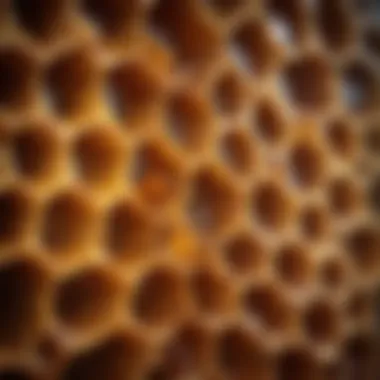
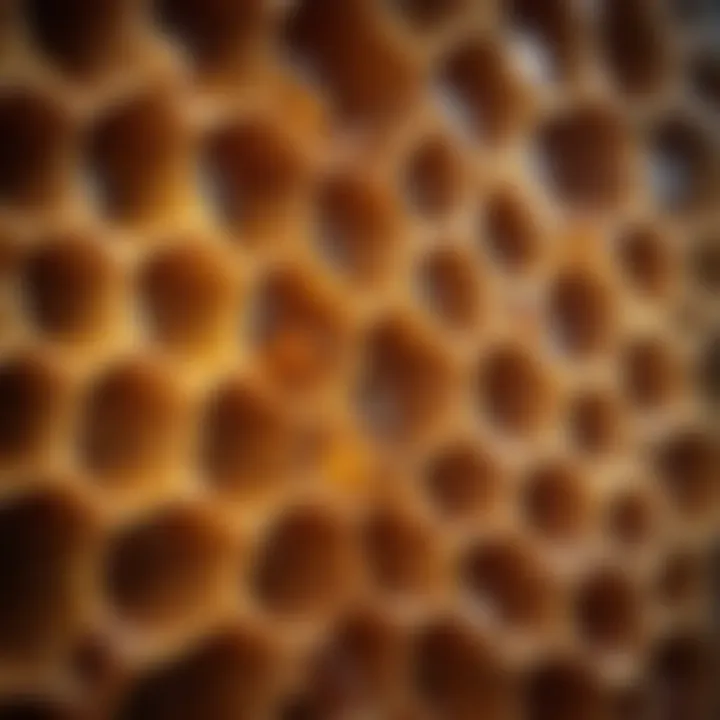
Intro
Honey, a sweet and viscous liquid, has been part of human culture for thousands of years. It's not merely a food item; it represents a unique interplay between nature, science, and tradition. From ancient Egyptians embalm their dead with honey to present-day gourmet uses in cuisine, honey has a multifaceted role in our lives. Understanding honey production deepens our appreciation for this remarkable substance and its vital contributors—the honeybees.
Overview of Research Topic
Brief Background and Context
Honey production is an ancient practice that has evolved dramatically over centuries. Initially gathered from wild bee colonies, modern methods involve carefully cultivated beehives. This shift reflects not only technological advancements but also a recognition of the critical role honeybees play in our ecosystem. The intricate relationship between these insects and their surroundings fosters biodiversity, making their preservation essential for a healthy environment.
Importance in Current Scientific Landscape
The rise of interest in sustainable living has brought honey and bees into the spotlight. As scientists emphasize the decline of bee populations, there is a greater understanding of their role in pollination and agriculture. This research is crucial as it informs conservation efforts, sheds light on the complexities of ecosystem dynamics, and emphasizes the nutritional and medicinal properties of honey. The narrative of honey production intertwines with discussions about climate change, agricultural practices, and health trends.
Methodology
Research Design and Approach
This analysis employs an interdisciplinary approach, drawing from fields including biology, ecology, and nutrition. By examining peer-reviewed studies, historical data, and case studies of contemporary beekeeping practices, we aim to create a well-rounded perspective on honey production.
Data Collection Techniques
Data were collected through:
- Analyzing academic journals and articles available on platforms like Wikipedia, Britannica, and specific bee-related publications.
- Conducting interviews with experienced apiarists to gather insights on practical beekeeping techniques.
- Reviewing current literature on honey's health benefits and its impact on human nutrition.
"Honey is not just a treat; it represents a crucial link to our environment, reflecting both its health benefits and the state of bee populations."
This article aims to establish a comprehensive understanding of honey production, emphasizing its ecological significance, nutritional value, and the challenges faced in modern apiculture. Through this exploration, we hope to foster a deeper appreciation for both honey and the tireless work of honeybees.
Prolusion to Honey
Honey is more than just a delicious natural sweetener; it embodies a rich narrative about ecology, agriculture, and nutrition. A crucial element of our ecosystem, honey not only supports a wealth of wildlife but also has impacted human culture and health for millennia. In this section, we aim to provide a comprehensive overview of honey, setting the stage for a deeper exploration of its production, varieties, and the challenges involved in beekeeping today.
Definition and Composition
Broadly speaking, honey is a thick, sweet substance produced by bees using nectar from flowers. However, the composition of honey is far more complex than its simple definition might imply. Honey contains more than just sugars; it is a rich cocktail of compounds that can vary based on factors such as floral source, local climate, and bee species. The primary sugars found in honey, fructose and glucose, are responsible for its sweetness and distinct flavor.
In addition to sugars, honey also contains trace amounts of vitamins, minerals, enzymes, and amino acids. For instance, B vitamins like riboflavin and niacin are present, which contribute to various metabolic processes in the human body. The acidity of honey also plays a role in its preservation; the low pH creates an inhospitable environment for bacteria, making honey a natural preservative. It's this blend of ingredients that makes honey not only a sweet treat but also a significant source of nutrition for those who consume it.
Historical Importance of Honey
The significance of honey throughout history cannot be overstated. Ancient civilizations revered honey as a symbol of prosperity and abundance. The Egyptians, for example, embedded it as a focal element of rituals and offerings. Honey was found in tombs, and some jars dating back thousands of years are still intact, preserving their contents. The Greeks and Romans also utilized honey, not just as a food source but as an offering in their religious practices.
Ultimately, beyond its cultural value, honey has served a medicinal purpose for centuries. From its use as a wound dressing in traditional medicine to its incorporation in various herbal remedies, honey's healing properties have been acknowledged across cultures. Its function in enhancing other herbal compounds underscores the deep-rooted belief in its curative attributes. In many societies, it remains a mainstay in home remedies, showcasing its enduring legacy across generations.
"Honey is the only food that includes all the substances necessary to sustain life, including water." - Bee Biology and Beekeeping
In summary, honey's definition and historical significance provide an essential context for understanding its role in both our lives and the environment. As we delve further, we will explore the intricate processes involved in its production, the varieties available, and the environmental factors affecting its yield.
The Role of Bees in Honey Production
Bees, particularly honeybees, play an essential part in the production of honey. Their hard work and unique biological traits enable them not just to gather nectar, but to transform it into a staple that has been cherished throughout history. The importance of bees in this process is multifaceted, touching on ecological balance, agricultural productivity, and the sustainability of honey as a resource. Without these industrious insects, we would face a considerable decline in both food resources and biodiversity.
Bee Anatomy and Functionality
Parts of the Honeybee
The anatomy of a honeybee is quite complex and directly contributes to its unique capability of producing honey. A honeybee is equipped with specialized body parts. For instance, the proboscis acts almost like a straw, allowing bees to efficiently collect nectar from flowers. The workers have pollen baskets on their hind legs, which are used to carry the pollen back to the hive.
Key Characteristic: One particularly striking aspect is their ability to communicate via the waggle dance. This behavior not only helps locate nectar-rich flowers but also contributes significantly to the hive's success in honey production.
** Advantages and Disadvantages:** The pollen baskets facilitate a more efficient collection process, making it easier for worker bees to gather what they need. However, these attributes come with a cost; in times of nectar scarcity, worker bees may struggle to sustain their hive.
Role of Worker Bees
Worker bees are the backbone of the hive. They handle everything from foraging for nectar to tending the queen and brood. Each bee works tirelessly, following a division of labor that enhances the hive's overall productivity.
Key Characteristic: The lifespan of a worker bee can range vastly depending on their role; for example, foragers live only a few weeks, while nurse bees can live several months. This short lifespan emphasizes their urgency in achieving the hive's goals.
Advantages and Disadvantages: The efficiency of worker bees ensures that the hive remains functional, but this rapid turnover significantly strains the population, especially during the prime foraging season when honey production peaks.
Lifecycle of Honeybees
The lifecycle of honeybees is another fascinating element that underscores their importance in honey production. It outlines a journey from egg to a fully functioning worker or drone, depending on the needs of the hive.
Egg Development
Egg development is the first step in the lifecycle of honeybees. The queen lays fertilized eggs that become worker bees or drones, depending on the needs of the colony. The temperature and humidity within the hive play critical roles in the successful development of these eggs.
Key Characteristic: Each egg hatches into a larva, which is then fed royal jelly or a mixture of nectar and pollen, allowing for rapid growth. This nurturing phase is crucial as it determines the health and productivity of future hive workers.
Advantages and Disadvantages: Rapid larval growth enables a quick replenishment of the population, vital for maintaining hive productivity. Yet, if conditions are not right, such as in times of excessive heat or cold, the viability of the brood can decline.
Role of the Queen Bee
The queen bee is often seen as the heart of the hive. Her primary role is reproduction, ensuring that the colony has a stable and robust population. This singular focus on egg-laying can be both beneficial and limiting.
Key Characteristic: What stands out about the queen is her ability to control the entire hive's reproductive strategy. If the colony is under stress, she might alter the sex ratio of the eggs being laid to sustain the hive.
Advantages and Disadvantages: While the queen's control over reproduction can ensure hive stability, it poses a risk if she fails or is lost, leading to the colony’s rapid decline.
In summary, the role of bees in honey production is significant. Their anatomy, social structure, and lifecycle intricately design a system that not only creates honey but also maintains the ecological balance. Understanding these factors sheds light on the paramount importance of protecting these vital pollinators.
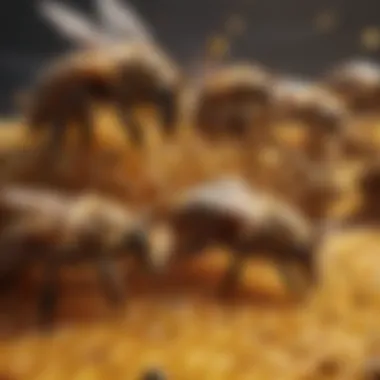
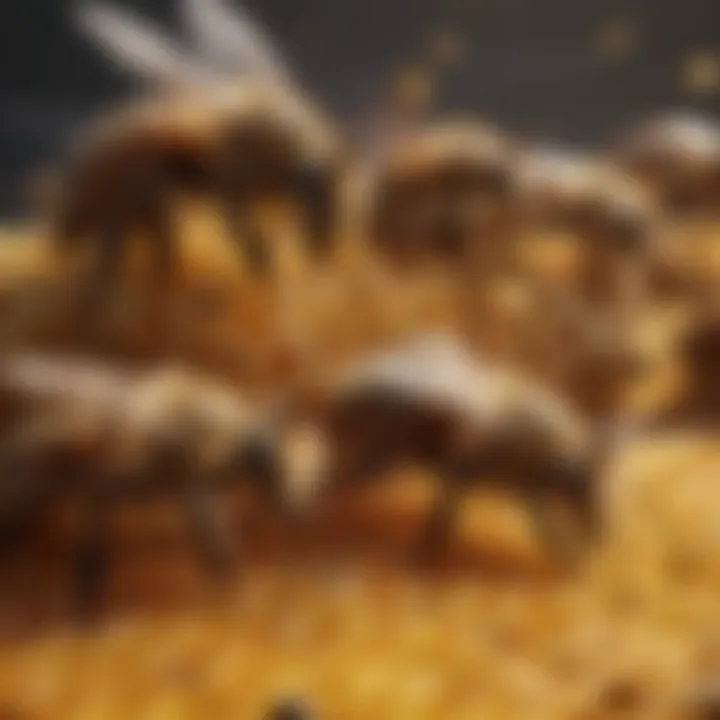
The Process of Honey Production
Understanding the process of honey production unveils the remarkable journey that nectar undergoes before it reaches our tables. This section is essential in any discourse about honey because it highlights how bees transform simple flower nectar into a complex and nutrient-rich substance. Furthermore, recognizing this intricate process provides insights into the importance of pollinators, their ecosystems, and the factors that ensure successful honey production.
Nectar Collection
Factors Influencing Nectar Availability
Nectar availability is driven by a variety of factors, including weather conditions, seasons, and types of plants. For instance, during a dry season, fewer flowers bloom, which leads to less nectar for bees to collect. A good understanding of these conditions is vital for beekeepers as they seek to optimize honey yields. One key characteristic of this topic is seasonal variation; for instance, bees thrive during spring when flowers are abundant. This seasonal bounty is a boon for honey production as it influences the quantity and quality of honey produced. However, fluctuating climatic conditions can severely curtail nectar supply, making it a double-edged sword for those in the honey business.
In summary, factors like local flora and climate play pivotal roles in what bees can access. It is a tricky balancing act that can directly benefit or hinder the honey industry.
Bees’ Foraging Behavior
Bees exhibit fascinating foraging behaviors that critically affect nectar collection. Worker bees engage in systematic foraging patterns to maximize their nectar intake. They communicate through dances, effectively sharing information about the richest flower patches with their fellow hive mates. The guiding trait here is the efficiency they display; a well-organized workforce results in increased honey stores for the colony.
However, their foraging behavior is not without its challenges.
- Distance: Too far from the hive can hinder foraging effectiveness.
- Pesticides: Environmental toxicity can deter bees from returning to certain areas.
Such behaviors underscore a compelling narrative about the coexistence of bees and their environment, emphasizing the need for harmony between nature and human activity to sustain honey production.
Conversion of Nectar to Honey
Enzymatic Action
Once bees have gathered nectar, the real magic begins as they convert it into honey. The key to this process lies in enzymatic action, specifically the enzyme invertase, which breaks down sucrose into glucose and fructose. This transformation is crucial because these simpler sugars are what give honey its sweetness.
What makes this process particularly special is its efficiency. Enzymatic action reduces the water content and enhances flavor complexity, making honey a distinctive product.
However, one must note that too high temperatures during processing can ruin this balance, leading to inferior honey that lacks the desirable qualities.
Evaporation Process
After enzymatic action, evaporation kicks in to further concentrate the honey. Bees generate warmth by beating their wings, helping to evaporate water from the nectar. This step not only affects viscosity but also influences shelf life and overall quality.
The unique feature of this evaporation process is that it gives honey its thick texture. The crux of this is that a well-executed evaporation results in honey's longer lifespan, which is otherwise prone to fermentation if left too watery.
The drawback, though, is that improper ventilation can lead to a less-than-perfect product, risking the integrity of the harvest.
Storage and Capping
Wax Production
After honey reaches the desired composition, bees begin to store it. This involves the production of wax, which is secreted from special glands on the bees' abdomens. This wax is incredibly vital; it forms honeycomb cells and acts as a protective barrier for the honey.
A significant aspect of wax production is its durability. Wax cells can hold honey without leaking, topping the list of material advantages for long-term storage. However, it does take a substantial amount of energy for bees to produce this wax, which can affect the colony's overall resource balance.
Sealing Techniques
Once filled, bees cap the honeycomb cells with more wax. This sealing is not merely decorative; it serves as a protective measure. By keeping moisture out, sealed honey remains fresh for extended periods, sometimes lasting years.
The capped honeycomb cells symbolize a job well done. The techniques are instinctual and precise, ensuring that bees maintain their food stores efficiently. However, one challenge here is that in cases of excessive humidity, bees may struggle to create the right seal, impacting the longevity of their precious product.
Engaging with the life cycle of honey production reminds us of our interconnectedness with nature and the delicate balance that sustains all living beings.
Varieties of Honey
Varieties of honey play a significant role in understanding its diverse applications and nutritional profiles. Each type of honey reflects the flora and fauna of its region, offering varying tastes and health benefits. By exploring these differences, one can appreciate honey not just as a sweetener but as a complex and rich substance with a story behind it, tied to the earth where it originated.
Floral Sources and Their Impact
Clover Honey
Clover honey is a highly regarded variety, known for its light color and mild taste. Its primary source comes from clover plants, which are abundant in many parts of North America. The key characteristic of clover honey is its subtle sweetness and floral undertones, making it a popular choice among honey consumers. It tends to have a smooth texture and is often described as being versatile in its culinary uses.
One unique feature of clover honey is its potential for health benefits; it is often praised for its antioxidant properties. These antioxidants are essential in combating oxidative stress in the body. However, while it’s highly beneficial, one disadvantage is that its flavor might be too mild for those who prefer a bolder type of honey.
Manuka Honey
Manuka honey stands out for its uniqueness, primarily harvested from the nectar of the Manuka tree found in New Zealand and Australia. Its most significant aspect is the presence of methylglyoxal, a compound recognized for its antibacterial properties. This feature has made Manuka honey a sought-after variety, especially in the realm of natural remedies and health products, where it’s often used in medicinal applications.
A critical selling point for Manuka honey is its distinct, robust flavor profile, which appeals to culinary enthusiasts and health-conscious consumers alike. However, a downside to Manuka honey is its higher price point, which can discourage some buyers. Balancing these factors, it's evident that its unique characteristics make it a valuable addition to discussions surrounding honey's role in health and nutrition.
Regional Differences
Local Climatic Influences
Local climatic influences play a vital role in determining the floral sources available for honey production in different regions. Honey harvested in warmer climates often exhibits different flavors and characteristics compared to those produced in cooler areas. For example, in areas with a Mediterranean climate, honey may have a more diverse range of floral sources, which can enhance its complexity.
The significance of local climate becomes clearer when examining the taste profiles; honey from warmer regions tends to be richer and can even offer a hint of spiciness. This aspect is beneficial for consumers looking for diverse flavors. A drawback, however, is that climate variability can affect the consistency and availability of certain honey types, making some of them harder to find.
Traditionally Harvested Honeys
Traditionally harvested honeys are integral to understanding the local cultures and practices surrounding honey production. These honeys are often collected using age-old methods passed down through generations, showcasing a direct connection between past and present beekeeping practices. A distinctive feature of traditionally harvested honeys is their often unprocessed nature, which preserves the raw benefits and flavors unique to their locality.
For instance, honeys gathered in rural areas might carry distinct local plant flavors, reflecting their geographic roots. This connection to tradition can be particularly appealing to consumers who value artisanal products. On the downside, the limited quantities produced may lead to higher prices and less availability than commercially produced varieties. However, the cultural significance and unique taste profiles often make these honeys worthy of examination.
Nutritional and Medicinal Properties
Understanding the nutritional and medicinal properties of honey is essential, especially considering its long-standing role in human history. Honey is not just a sweetener but a powerhouse of nutrients and medicinal qualities that contribute significantly to health and wellness. Its diverse benefits, ranging from essential vitamins and minerals to powerful antioxidants, make it an invaluable addition to diets worldwide.
Nutritional Benefits
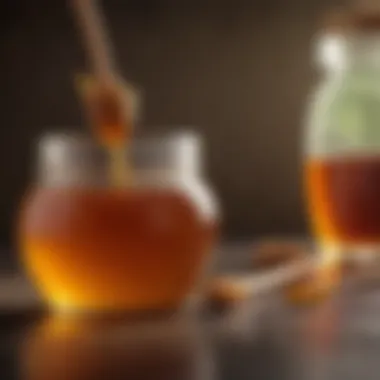
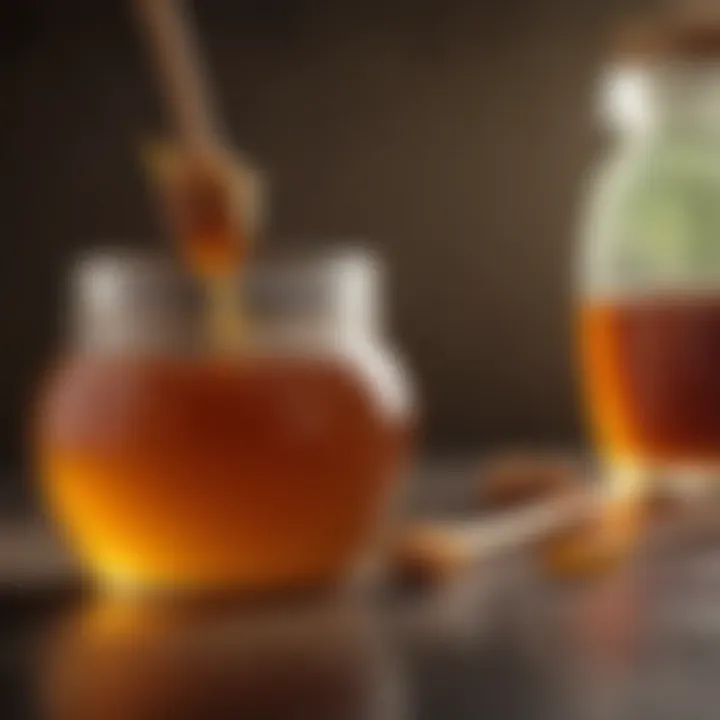
Vitamins and Minerals
Honey contains a treasure trove of vitamins and minerals that play a vital role in supporting our health. Some of the key vitamins found include B vitamins such as riboflavin, niacin, and pantothenic acid, all critical in energy metabolism. Moreover, honey is rich in minerals like calcium, iron, magnesium, and potassium, which are vital for various bodily functions. These nutrients contribute not only to maintaining healthy bodily functions but also enhance overall vitality.
The unique aspect of honey’s vitamin and mineral content is that it varies with the floral source, leading to a wide array of benefits depending on the honey type. For instance, darker honey generally contains higher levels of antioxidants and minerals. However, it’s crucial to note that while honey is beneficial, moderation is key, as excess sugar intake can lead to health issues.
Antioxidant Potential
The antioxidant potential of honey cannot be overstated. It contains flavonoids, phenolic acid, and other compounds that help combat oxidative stress in the body. These antioxidants work to neutralize free radicals, reducing the risk of chronic diseases and supporting overall health.
One important feature of honey's antioxidant properties is its ability to promote heart health. Studies have shown that honey may help lower cholesterol levels and improve cardiovascular health, making it a popular choice among health-conscious individuals. While this is beneficial, it is vital to recognize that not all honeys are created equally; higher-quality, raw honey tends to have greater antioxidant content.
Historical Medicinal Uses
Honey in Traditional Medicine
Historically, honey has served as a cornerstone in traditional medicine in various cultures. For centuries, it has been used not only as a food but also as a natural remedy for ailments ranging from sore throats to digestive problems. Its antibacterial properties make it effective in wound healing, as it helps fight infections and promotes tissue regeneration.
The remarkable aspect of honey in traditional medicine is its ability to provide relief while also boosting the immune system. This dual functionality has led to its enduring popularity as a natural remedy. However, one must consider that while honey is beneficial, it is not a substitute for conventional medical treatments.
Contemporary Applications
In modern medicine, honey has found its way into various applications, particularly in wound care. Manuka honey, originating from New Zealand, has gained recognition for its potent antibacterial properties and is widely used in medical settings for treating wounds and burns.
The contemporary use of honey in health supplements and natural remedies highlights its versatility and ongoing relevance in today’s health landscape. Importantly, research continues to delve into the myriad benefits of honey, exploring its uses in managing conditions like diabetes and other metabolic disorders. Yet, while honey can be beneficial, individuals should consult healthcare providers before using it as a primary treatment option.
Honey's multifaceted properties establish it as not only a sweetener but also an ancient healing agent, grounding its place in both historical lore and contemporary healthcare.
Beekeeping Practices
Beekeeping practices play a pivotal role in the world of honey production. Understanding the nuances of how bees are raised, managed, and cared for offers crucial insight into the overall quality and sustainability of honey. There are varied beekeeping methods, each uniquely suited to different goals, environments, and experiences. Whether it’s aimed at commercial profit or personal enjoyment, beekeeping affects not just the beekeepers but also the environment, agricultural yield, and consumer health. A well-managed beehive can yield a treasure trove of benefits, from increased pollination to valuable honey.
Types of Beekeeping
Commercial Beekeeping
Commercial beekeeping focuses on maximizing honey production and often involves large-scale operations. Beekeepers in this field usually manage hundreds or even thousands of hives, leading to significant economic yields. One of the primary advantages of commercial beekeeping is its ability to meet the demands of a growing market. The strong emphasis on efficiency often results in honey that is readily available in stores worldwide.
However, this approach comes with its challenges. Intensive practices can sometimes overlook bee welfare, leading to stressed colonies and a lack of genetic diversity. High-density hive management may also be vulnerable to diseases and pests, creating tight situations for both bees and beekeepers.
Backyard Beekeeping
Backyard beekeeping, often deemed more personal and intimate, has gained traction among hobbyists and those looking to actively contribute to their local ecosystem. This form of beekeeping takes place in residential settings where individuals or families tend small numbers of hives. Its greatest charm lies in the close relationship formed between beekeeper and bees, enabling hands-on learning and a deeper appreciation for nature.
This approach promotes biodiversity as backyard beekeepers often plant a variety of flora to support their hives. Moreover, it encourages self-sufficiency; many backyard beekeepers harvest their honey, creating a product that is both pure and local. Yet, it demands a commitment to continual learning and can be affected by limited space and local regulations.
Sustainable Beekeeping Techniques
Sustainable beekeeping techniques present solutions to some of the challenges presented by both commercial and backyard approaches. These practices emphasize the health of the bees and their environment, aiming for an equilibrium that benefits all parties.
Integrated Pest Management
Integrated Pest Management (IPM) is a holistic approach to controlling pests while minimizing chemical exposure. It includes practices such as monitoring hive health, using natural predators, and applying bio-controls. The central idea behind IPM is to manage pest populations through an array of techniques, rather than relying solely on pesticides.
This method is particularly beneficial as it helps maintain the health of the bee populations and reduces the risk of developing pesticide resistance. A unique feature of IPM is its adaptability to local conditions and the diverse challenges beekeepers face. However, it requires keen observation and understanding of ecological balances, which can be daunting for new beekeepers.
Organic Beekeeping Methods
Organic beekeeping methods have become popular among those interested in ethically sourced honey. This practice forbids synthetic chemicals in handling bees and their hives. The aim is to cultivate a chemical-free environment, leading to naturally produced honey and healthier bee colonies. In organic settings, beekeepers focus on nurturing their bees through natural means, like offering a varied diet.
Though it can often be seen as a more labor-intensive method, organic beekeeping also assures consumers of the purity of their honey. However, this approach can face challenges such as fluctuating yields and the need for stricter regulations. Over time, organic beekeeping has shown great promise in enhancing both biodiversity and bee health.
"Sustainable practices in beekeeping not only protect bee populations but also ensure a healthier future for honey production and our ecosystems."
In sum, understanding these practices provides a solid foundation for appreciating the diverse world of honey production. Whether through commercial or backyard styles, the choices made by beekeepers echo far beyond individual hives, impacting the agricultural landscape and environment at large.
Environmental Factors Affecting Honey Production
Understanding the environmental factors that affect honey production is crucial to grasping the complexities of apiculture. Factors such as climate, biodiversity, and ecosystem health play pivotal roles in the quantity and quality of honey produced. Changes in these elements can lead to significant repercussions for both beekeepers and bees. The health of bee populations, efficiency in production, and the overall availability of honey is deeply intertwined with environmental conditions. Hence, this section aims at elucidating these factors, primarily focusing on climate change impacts and biodiversity, providing insights necessary for sustainable honey production.
Climate Change Impacts
Temperature Variations
Temperature variations directly influence bee activity, nectar flow, and ultimately, honey production. When temperatures are warmer, bees are likely more active, leading to increased foraging behavior. This can have both positive and adverse effects on honey production. On one side, warmer weather can lead to extended foraging periods, which can help gather nectar from flowers that bloom early in spring. However, excessive heat can also stress bee colonies, leading to lower productivity. Another key characteristic of temperature variations is their influence on local floral abundance. Different plant species react to temperature changes differently; some may thrive while others may dwindle. This could consequently alter the foraging patterns of honeybees.
The unique feature of temperature variations is that they create a double-edged sword scenario. While moderate increases can promote bee activity, extreme temperatures can lead to hive abandonment or even colony collapse. Thus, careful monitoring of local climate trends is vital for both beekeepers and researchers to devise appropriate strategies to mitigate adverse effects.
Effects of Weather Extremes
Weather extremes encompass harsh conditions like storms, prolonged droughts, or unseasonal frosts. Each of these factors can drastically disrupt nectar availability. For instance, a late frost can damage blooming flowers, reducing the nectar supply which is essential for honey production. Extreme weather is notable for its unpredictability, making it a significant consideration for farmers and beekeepers alike.
The key characteristic of effects from weather extremes is their abrupt and often unforeseen impact on honeybee foraging habits. This can lead to reduced honey yields and even heightened competition among colonies for dwindling resources. Furthermore, the unique feature of these extremes is their ability to markedly affect the entire ecosystem. Changes in rainfall patterns can directly impact the health of plants, which, in turn, affects the bees that rely on them. The advantages are fewer than the disadvantages in this context. While certain weather patterns might favor a brief flourishing of flora, the long-term effects tend to lean toward instability in bee populations and honey production.
Biodiversity and Ecosystem Health
Floral Biodiversity
Floral biodiversity serves as a cornerstone for healthy ecosystems and thriving honey production. The variety of plants available for bees is essential; different flowers yield different nectars, which not only diversify the bees' diets but also enrich the characteristics of the honey produced. Higher floral biodiversity contributes to better pollinator health and resilience, creating a robust environment for honeybees.
The primary characteristic of floral biodiversity is its ability to assure consistent nectar availability throughout the seasons. Diverse plant life can mitigate the risks posed by climate change, in that if one type of flower fails to thrive, others may still provide valuable resources for the bees. The unique feature of this aspect lies in how it can enhance both the sustainability of honey production and the ecological balance overall. However, a drawback can be seen if there's an over-reliance on a few dominant species, which may lead to vulnerability in case of disease or environmental shifts.
Pollinator Health


Pollinator health is interlinked with honey production. Healthy bee populations are essential as they are the primary agents in the pollination of a vast array of plants. This, in turn, supports the floral biodiversity that sustains both the bee colonies and the overall ecosystem. An important characteristic of pollinator health is its susceptibility to environmental changes—like pesticides or habitat loss—which can have catastrophic consequences. Protecting pollinators means safeguarding the biodiversity necessary for thriving bee populations.
The unique feature of focusing on pollinator health is emphasizing holistic approaches to maintaining honey production. Strengthening bee health through better management practices can lead to higher yields while promoting the conservation of their natural habitats. On the surface, this seems exceptionally beneficial; however, the challenge remains in translating this understanding into actionable measures. Ensuring consistent habitats and promoting practices that favor bee health ultimately influences honey production long-term.
"Healthy bees are the backbone of thriving ecosystems and sustainable honey production."
Challenges Facing Honey Production
Honey production is at a crossroads, with various challenges threatening both bee populations and the quality of honey. Understanding these obstacles is crucial for anyone invested in apiculture, whether they're professional beekeepers, researchers, or enthusiasts. Factors like pesticide use, diseases, and environmental variations all play a significant role in the ability of honey producers to maintain healthy hives and produce high-quality honey. Addressing these issues not only ensures the survival of bee populations but impacts biodiversity and global food production as well.
Pesticide Use
Impact on Honeybees
Pesticid use has been a sore point in the discussion around honey production, as it directly affects bee health. Many common pesticides, particularly neonicotinoids, have been linked to decreased honeybee populations. These chemicals interfere with a bee’s ability to navigate, forage, and reproduce.
"The decline in honeybee colonies is like canaries in a coal mine, warning us about the toxic environment."
This direct impact on bees is a vital aspect; if their numbers continue to dwindle, not only does honey production suffer, but also pollination of critical crops. It becomes a vicious cycle where fewer bees mean less honey, which in turn affects crop yields and biodiversity.
On the flip side, many farmers argue that, without pesticides, crop losses would increase significantly. Thus, the pros and cons of pesticide use create a complex dilemma in modern agriculture that can't be brushed aside easily.
Legislative Responses
In response to the glaring effects of pesticides on bee populations, various legislative measures have been proposed and, in some cases, enacted. For instance, certain regions have banned specific harmful pesticides or have placed restriction on their use during vital foraging seasons. These sweeping legislative responses are essential to promoting better beekeeping practices.
Through legislation, beekeepers can engage in more sustainable methods of production and those promoting organic practices are gaining traction. This intersection of beekeeping and policy makes it a compelling discussion point, as health of honeybees is increasingly becoming a matter of public concern. However, while these laws offer hope, their enforcement can vary, and there is often pushback from agricultural sectors that rely on chemical pesticides for high yields.
Diseases and Pests
Varroa Mites
Varroa mites pose one of the most significant threats to honeybee health. These external parasites latch onto bees and feed on their bodily fluids, leading to weakened colonies and even death. The unique feature of Varroa mites is their ability to quickly reproduce, making them a sneaky enemy that can devastate local bee populations.
In many regions, without effective control methods in place, beekeepers have found themselves battling these pests through various mechanical or chemical approaches. However, these methods often have their downsides—what works in one region or system may not be effective in another, making Varroa management a complicated affair.
Nosema
Nosema is another prominent disease that afflicts honeybee colonies. This intestinal parasite can lead to poor health and reduced survivability. It thrives in stressed environments, and outbreaks often coincide with other challenges, such as poor nutrition or extreme weather.
One of the key characteristics of Nosema is its subtlety; infected bees may show very few symptoms until it's almost too late to act. This insidious nature makes monitoring and management quite tricky. Unlike Varroa mites, controlling Nosema often involves a broader focus on bee nutrition and overall hive health, which calls for a more integrative management approach.
In the grand scheme of things, both Varroa and Nosema as challenges represent a multifaceted problem that necessitates both attention and action—not just from beekeepers, but from everyone invested in maintaining the ecosystem.
The Future of Honey Production
The landscape of honey production is continuously evolving, shaped by changing environmental conditions, technological advancements, and the pressing need for sustainable practices. This section focuses on how the future is being crafted not only through innovations but also through active community involvement and policy-making. It reflects the necessity of understanding these developments for ensuring the longevity and viability of beekeeping.
Innovations in Beekeeping
Technological Advances
Technological advances in beekeeping are revolutionizing how honey is produced, monitored, and harvested. One aspect to consider is the development of smart hives equipped with sensors that track hive temperature, humidity, and even bee activity. These smart technologies allow beekeepers to have real-time data, aiding in swift decision-making that could prevent colony loss. Moreover, automation in the honey extraction process can reduce labor costs and improve efficiency.
The key characteristic of these innovations is their potential to increase productivity while minimizing human intervention. By monitoring environmental factors and bee health remotely, beekeepers can ensure optimal conditions for honey production. The unique feature here includes the ability to analyze data comprehensively, which invites better management practices. However, one downside could be the initial cost of implementing such technology, which might be a hurdle for small-scale beekeepers.
Research Trends
Research trends are another critical element shaping the future of honey production. Scientists are increasingly studying the relationship between hive health and environmental factors to create more resilient bee colonies. For instance, ongoing studies focus on the effect of different floral sources and their nutritional quality on honeybees. This emerging knowledge can guide beekeepers in selecting suitable plant varieties in their regions, enhancing bee welfare and honey quality.
One of the key characteristics of this research is its interdisciplinary approach, where ecology, biology, and technology converge to provide comprehensive solutions. The unique feature of this trend is the adoption of citizen science projects where beekeepers contribute to data collection. This can foster community involvement and a sense of shared responsibility. However, a challenge lies in ensuring that research findings are communicated effectively to beekeepers, enabling them to implement practical changes.
Conservation Efforts
Community Engagement
Community engagement plays a vital role in promoting sustainable beekeeping practices. Local beekeeping clubs and organizations often lead efforts to educate the public about the importance of bees in ecosystems. For example, workshops and school programs introduce the next generation to apiculture, instilling a sense of responsibility towards bee conservation.
The key characteristic of community engagement is its grassroots nature, which democratizes knowledge and makes it accessible to more individuals. Initiatives like community gardens can also boost local bee populations by providing diverse nectar sources. A unique feature of community involvement is creating bee-friendly cities; however, it may require substantial commitment from local governments to implement these ideas widely.
Policy Advocacy
Policy advocacy is essential for the future of honey production as it shapes the legislative framework in which beekeepers operate. Advocacy groups work tirelessly to influence laws regarding pesticide use, land use, and funding for beekeeping research. This aspect is crucial because effective policies can lead to greater protections for bee populations and supportive incentives for sustainable practices.
One key characteristic of policy advocacy is its ability to unify multiple stakeholders, from beekeepers to environmental organizations. Their concerted efforts can ensure that beekeeping regulations protect both the bees and the interests of producers. A unique feature of advocacy is its ability to create public awareness; though, the ephemeral nature of political focus can sometimes lead to stagnation in urgent cases.
In summary, the future of honey production stands at a crossroads, guided by technological leads, research directions, community actions, and policy frameworks. All these dimensions hold the promise of sustaining not just honey production but also creating a healthier environment for bees to thrive. By understanding these dynamics, stakeholders involved in the realm of apiculture can better prepare for the challenges and opportunities that lie ahead.
End
Drawing the curtains on this exploration of honey production, it’s clear that the relationship between honeybees and their environment is a delicate dance of biology, sustainability, and culture. The journey of honey from beehive to table encapsulates much more than just a sweet substance; it illustrates a complex web of interactions that highlights the essential role bees play in our ecosystems. Notably, as we have seen, the nutritional and medicinal benefits of honey extend far beyond its taste, anchoring it firmly in both historical and contemporary contexts.
Furthermore, the ever-present challenges faced by honey production, such as climate change and pesticide use, call for a concerted collective effort to safeguard these industrious pollinators. The future of honey rests not only in innovation within beekeeping practices but also in our commitment to sustainability. Without action, the gap between the demand for honey and its responsible production will only widen.
Summary of Findings
In this article, we have delved deep into several notable elements surrounding honey and its production:
- Bee Biology: Understanding the anatomy and behavior of bees provides insights into their vital roles in honey production.
- Processes Involved: From nectar collection to the unique conversion processes, every step is crucial in shaping how honey is made.
- Health Benefits: Rich in antioxidants and having historical medicinal uses, honey remains a valuable addition to diets.
- Sustainable Practices: Special attention has been given to the importance of sustainable beekeeping, emphasizing the need to innovate responsibly.
- Environmental Impact: The delicate balance between honey production and environmental health has been highlighted, stressing the consequence of ignoring pollution and climate change.
At its core, honey production serves as a microcosm for wider ecological issues, illuminating how interconnected our natural systems are.
Call to Action for Sustainable Practices
Thus, as stewards of this earth, it falls upon each of us to pave the way for sustainable practices concerning honey and its bees. Here are some essential steps that can be taken:
- Support Local Beekeepers: Buying honey from local producers not only supports the community but also encourages responsible beekeeping practices.
- Advocate for Bees: Encourage local legislation that protects pollinators, such as restrictions on harmful pesticides.
- Educate Yourself and Others: Awareness is half the battle; informing others about the significance of bees and their role in the ecosystem can initiate change.
- Create Bee-Friendly Habitats: Planting native flowers and gardens can provide essential sustenance for honeybees.
- Engage in Sustainable Products: Consider incorporating organic or sustainably sourced honey in your diet, minimizing the ecological footprint.
"It's not just about enjoying honey; it's about ensuring the future of the bees and the planet we all share."
By taking these small yet impactful steps, we can ensure that honey production remains viable and that the health of our ecosystems is preserved for generations to come. The sweet taste of honey should not come at the bitter price of ecological neglect.



